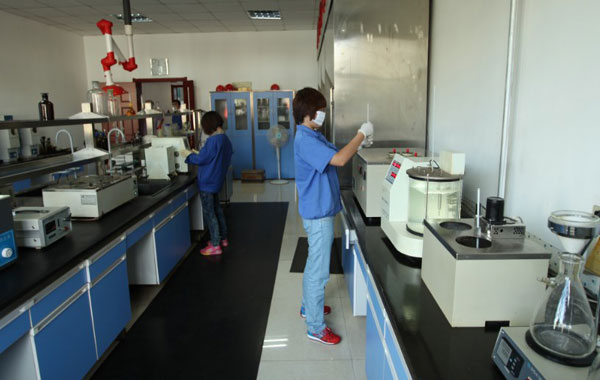
Recently our group will give priority to the following six items (four in modern coal chemical industry technology and two in GHG reduction technology):
I. 6.0MPA pressure gasification technology for coal crushing in static bed. This technology is of technical maturation, stable operation, high recovery of byproducts, efficient energy conversion. Especially high content of methane in raw gas, it is very suitable for coat to gas project. However, waste water is hard to deal with and its major defect lies in low production capacity of single oven caused by low reaction pressure. The reaction pressure of gas making oven in static bed has never break through 4.0MPA for many years.
In order to maintain the above advantages in gas making, improve reaction pressure, raise single oven productivity and realize a large scale production, Kingho Group has entered a cooperative agreement with Sedin Engineering Co., Ltd. to jointly develop pressure gasification technology for coal crushing in static bed in Feb. 2010. In so far, its laboratory work has been accomplished in Taiyuan University of Science and Technology and complete experimental data has been gained. Starting from that, together with Sedin Engineering and Taiyuan University of Science and Technology, the group plans to stretch out test work for 6.0MPA pressure gasification technology through engineering approaches based on public utility of Phase I of coal-gas project of our group.
II. Domestic methanation technology. Most of core technologies in coal-gas processing have been localized. Only methanation technology has no engineered case. At present, all domestic coal-gas projects in implementation stage has purchased process package and catalyst from Haldor Ropsoe (Xinjiang Kingho and Inner Mongolia Huineng) or Davy Process Technology Ltd. (Datang Keqi and Datang Fuxin).
To get earlier localization of whole process of coal-gas, Kingho has entered a cooperative agreement with Dalian University of Technology and Southwest Research Institute of Chemical Industry (hereinafter referred to as Southwest Research Institute) in early 2011. Based on current process package and catalyst of “coke-oven gas to methane” (A Project with productive gas of 20,000 me of Chemical Induruction of Shanxi Guoxin Building Junxin Energy Co.,Ltd.), the company develops methanation technology and catalyst suitable for coal-gas project.
III. Research and development of methanol synthesis process (1 MT per year) and catalyst. There is an important intermediate in modern coal chemical industry. However, methanol synthesis process with independent intellectual property rights has never reached an annual output of 300,000 tons per year. Thus, many MTO and MTP projects at home have to bring in foreign process and catalyst.
Our group has recently entered a preliminary agreement with Sedin Engineering and Southwest Research Institute to develop the methanol synthesis process of 1 MT per year based on the process of 0.3 MT per year owned by Southwest Research Institute (Shenhua Wuhai Coke-oven Gas to Methanol Project that has put into production for more than one year).
IV. Recently the group plans to work with Tsinghua University, Dalian University of Technology and Xinjiang University to apply the 2012 National Science-technology Support Plan Project——“ional Science-technology SuppoCoal-gas System, Key Technology and Process Integration for Cascade Utilization of Energy and Pollutant Control and Reduction”.
This project contains four aspects: 1. Optimize key control parameters for each production unit based on gross energy of the whole coal-gas system; 2.Study “three wastes” in coal-gas system, especially the control and reduction technology of waste water pollutant to get a higher water recycling efficiency; 3. Research and develop special catalyst for synthesis gas from carbon dioxide and coal bed gas; 4. Research and develop key process conditions for synthesis gas, converge the process flow of full methanization into the main system and complete element tasks for new low carbon footprint coal-gas technology. The above results will be firstly used in our coal-gas devices. Once we make it in industry production, it will greatly push forward coal-gas project at home and even all over the world.
V. Carbon dioxide to methanol technology. Carbon dioxide emission presents the biggest obstacle in coal chemical industry. If it can be used as feed gas, not only GHG emissions will be reduced, energy efficiency of fossil fuel will be significantly improved. For its properties, carbon dioxide rarely takes part in chemical reaction. Many countries are looking at carbon dioxide to methanol technology. In the middle of May 2011, Mitsui Chemicals released the information that its hundred ton experimental facility for carbon dioxide-to-methanol has been in stable operation, which causes a sensation in the industry.
In 2008, Southwest Research Institute has successfully developed pilot plant for carbon dioxide-to-methanol and has been reviewed by experts from MOST. Our group has entered an agreement with Southwest Research Institute to jointly develop and build industrial plant for ten thousand tons of carbon dioxide-to-methanol. The project is planned to be implemented in the second half of 2011. If successful, it will be the largest carbon dioxide-to-methanol plant in the world and bring major breakthroughs for GHS reduction technology all over the world.
VI. Polybasic gasification agent technology for carbon dioxide. Coal-gas project will discharge part of carbon dioxide under control. In order to reduce emissions and improve energy efficiency, Kingho Group has entered an agreement with Sedin Engineering in Feb. 2010 to develop polybasic gasification agent technology, which returns carbon dioxide to the gasification furnace in a organized way so as to partly replace water vapor and oxygen as a gasification agent (namely CO2+C=2CO replaces H2O+C=CO+H2 to get effective CO). While capturing carbon dioxide, it reduces the use of water vapor thus to decrease waste water treatment.
Copyright 2013-2023 CHINA KINGHO , All Rights Reserved
